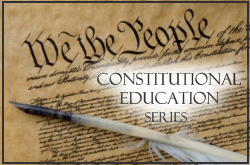 It’s important that we educate our children on the topics of politics, government, and the Constitution which governs our nation. This nine-part series reminds us of some basic principles, lest they be forgotten by the next generation. The following questions provide material for homeschool and public school teachers to share, discuss, and test their students on each of the nine topics. The link to each article is included, or you may start through the series beginning at Constitutional Education – Free Homeschool Curriculum (a nine-part series, originally published in January/February 2009). The discussion questions are divided up into three installments, beginning here.
It’s important that we educate our children on the topics of politics, government, and the Constitution which governs our nation. This nine-part series reminds us of some basic principles, lest they be forgotten by the next generation. The following questions provide material for homeschool and public school teachers to share, discuss, and test their students on each of the nine topics. The link to each article is included, or you may start through the series beginning at Constitutional Education – Free Homeschool Curriculum (a nine-part series, originally published in January/February 2009). The discussion questions are divided up into three installments, beginning here.********************
7. Banking and The Federal Reserve Act (Part 7)
· What is the difference between a Silver Certificate and a Federal Reserve Note? [A Silver Certificate was backed by real silver, and could actually be exchanged for the amount in silver at the treasury. A Federal Reserve Note is not backed by precious metal or anything of value, but is only worth the face amount because the government says so.]
· What was the purpose for the creation of the Federal Reserve in 1913? Did it work? [The Federal Reserve was created in 1913 with the purpose of being able to expand or contract the money supply if the government decided it was needed. They feared that people might place a demand for their money or that the stock market was too volatile without this “control”. Unfortunately, it did not work, because the stock market crashed in an historic manner just sixteen years later. The economy continues to fluctuate as much or more than it did before the Federal Reserve was created.]
· What economic occurrence happened after the Federal Reserve was created, one that had not happened before? Explain what this occurrence does to prices. [Inflation occurred after the creation of the Federal Reserve. Prior to this, the prices of goods remained essentially the same for over a hundred years. When the Reserve was given the power to print money, the supply of money goes up and the value of each dollar goes down. This causes prices to rise. This continues to happen today.]
· Extra – Go to your library and check out an 1897 Sears catalog or an 1895 Montgomery Ward catalog (these are readily available at most libraries) or locate other old catalogs from department stores. Compare the prices of similar items from back then to prices today. Calculate the percentage rise in prices for different items. Do you observe the effect of inflation?
· Extra – Do you believe the economy would be better served with more or less government intervention? Do you think a return to the gold or silver standard would be beneficial or harmful?
8. (Mis)interpreting the General Welfare Clause (Part 8)
· Where does the General Welfare clause appear in the Constitution? [It appears twice – once in the Preamble and once in Article 1, Section 8.]
· Does the Constitution explicitly give the federal government the ability to collect taxes and distribute them to states for road construction projects? [No, the Constitution is fairly silent about what the government may spend money on. From a previous lesson, we see that they are directed to fund the military for the protection of our nation, but there is little else that is named specifically in the Constitution that the government may fund.]
· In today’s federal government, is there very much debate about whether or not the government should be involved in a spending program? [We still see some debate in a couple of areas – most notably in the areas of gun laws or abortion. People feel passionately about these topics and so they still make arguments about whether or not the government should be involved. But by and large, most people now raise no questions about whether or not the government should be involved in spending for road construction, healthcare, etc. It’s become a foregone conclusion. However, in the era of the founding fathers, there would have been much debate over these issues and whether the government should participate.]
· Extra – How do you feel about the topic of government spending on various programs? Consult today’s news media and make a list of programs where you see the government spending tax money. Are these areas listed in the Constitution or the Amendments?
· Extra – In your opinion, did most founding fathers intend for the amount of government spending and involvement that we have today? You might look up some quotes from Thomas Jefferson, Alexander Hamilton, John Adams and Patrick Henry.
9. The Birth of Judicial Activism (Part 9)
· When Marbury brought his case before the Supreme Court, what exactly was the purpose of his case? [It was simply to get Hamilton to sign his commission, so that he could take on the role of a federal judge. Marbury cited the Judicial Act of 1789 as the basis for his lawsuit.]
· What was the unprecedented (and some would say shocking) thing that the Supreme Court did regarding Marbury’s case? [They referred the case back to a lower court, but at the same time declared that the Judiciary Act was unconstitutional. This was never before done – that is, the Supreme Court had never before declared something to be unconstitutional (nor had they been asked to rule on the constitutionality of something). The shocking part was that the Court decided on its own that it had the authority to make this judgment.]
· State the difference between judicial activism and judicial restraint. [Judicial activists believe that there are implied powers in the Constitution and that the document is up for changing evaluation and interpretation as the times change. This results in the government expanding its powers over more and more topics as time goes on. Those who believe in judicial restraint believe that the Constitution is very explicit about areas where the government should be involved. They believe that where the Constitution is silent about a topic, the government likely has no authority.]
· What fictitious human right did the Supreme Court refer to in the Roe vs. Wade case? [The right to privacy was the basis of their argument. While most people may agree that privacy is a good thing, there is no mention of a right to privacy in the Constitution. The word does not even appear in the Constitution.]
· Extra – What is your opinion on judicial activism versus judicial restraint? Do you believe in one over the other? Give your reasons.
· Extra – Do some research on Justice John Marshall. How do you think he was viewed by judicial restraint advocates such as Thomas Jefferson?
**************
Back to the beginning of the Constitutional Education series....











No comments:
Post a Comment